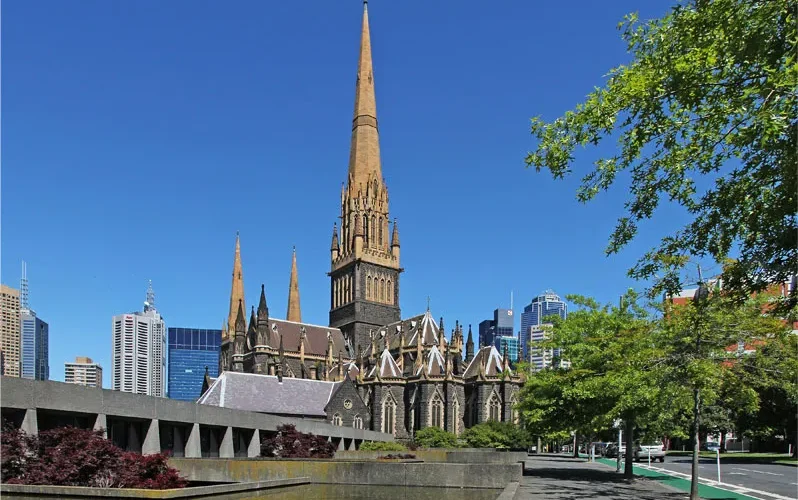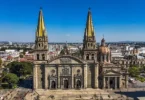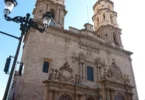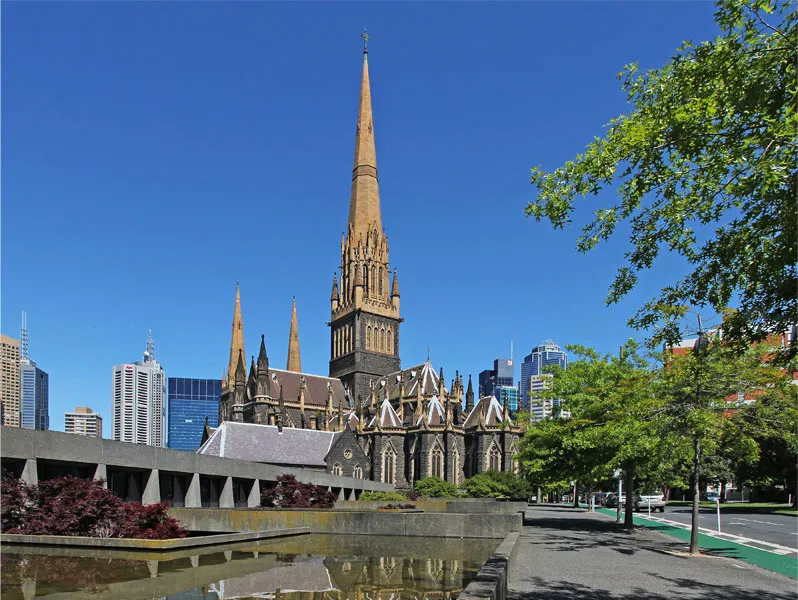
Introduction
The Cathedral Church and Minor Basilica of Saint Patrick (colloquially St Patrick’s Cathedral) is the cathedral church of the Roman Catholic Archdiocese of Melbourne in Victoria, Australia, and seat of its archbishop, currently Peter Comensoli. In 1974 Pope Paul VI conferred the title and dignity of minor basilica on it. In 1986 Pope John Paul II visited the cathedral and addressed clergy during his papal visit.
The cathedral is built on a traditional east–west axis, with the altar at the eastern end, symbolising belief in the resurrection of Christ. The plan is in the style of a Latin cross, consisting of a nave with side aisles, transepts with side aisles, a sanctuary with seven chapels, and sacristies. The cathedral was listed on the Victorian Heritage Register on 5 August 1999.
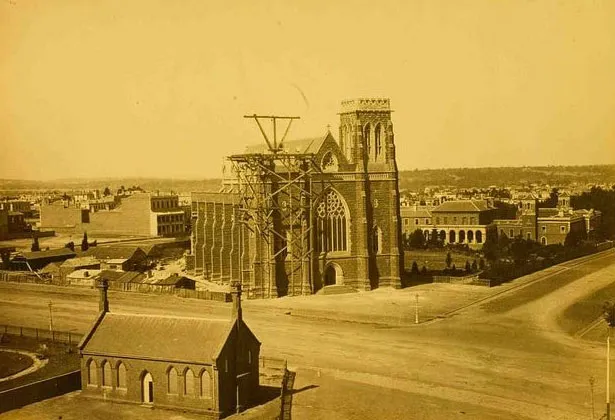
In 1848, the Augustinian friar James Goold was appointed the first bishop of Melbourne and became the fourth bishop in Australia, after Sydney, Hobart and Adelaide. Negotiations with the colonial government for the grant of five acres of land for a church in the Eastern Hill area began in 1848. On 1 April 1851, only 16 years after the foundation of Melbourne, the Colonial Secretary of Victoria finally granted the site to the Roman Catholic Church. Goold decided to build his cathedral on the Eastern Hill site. Since the Catholic community of Melbourne was at the time almost entirely Irish, the cathedral was dedicated to St Patrick, the patron saint of Ireland.
In 1851 a start was made, but with every able-bodied man in the colony soon rushing to the goldfields, not much was built by 1856, when Goold commissioned a larger one, using a design by Charles Hansom, but only the south aisle was built by 1858 when Goold appointed the recently arrived English architect William Wardell to design a far larger one. Wardell was an accomplished architect, known especially for a series of Catholic churches in London, all in Gothic Revival style, and was part of the circle around one of the leading exponents of the Gothic for churches, Augustus Welby Pugin.
St Patrick’s Cathedral draws on the Gothic style of late thirteenth century, based on the great medieval cathedrals of England. The style is specifically Geometric Decorated Gothic, showing this style at its most complex in the large west window of the nave. The eastern arm with its chevet of radiating chapels in the French manner is still principally in the English late thirteenth century style, giving the most complete essay attempted in that style during the nineteenth century. William Wardell was a remarkably ambitious and capable architect; he went on to design the second St Mary’s Cathedral, Sydney, in a similar style, even larger than St Patrick’s, but with a completely English square East End. In 1974 Pope Paul VI conferred the title and dignity of minor basilica on it. In 1986 Pope John Paul II visited the cathedral and addressed clergy during his papal visit. The building also saw a green ban in the 1970s.
Architecture of St. Patrick’s Cathedral
In 1858 William Wardell was commissioned to plan the cathedral with a contract signed on 8 December 1858 and building commencing the same year. St Patrick’s Cathedral with scaffolding and St Patrick’s School, Eastern Hill c. 1866 State Library Victoria H2119
Although the nave was completed within 10 years, construction proceeded slowly, and was further delayed by the severe depression which hit Melbourne in 1891. Under the leadership of Archbishop Thomas Carr the cathedral was consecrated in 1897 and even then it was not finished. Given the size of the Catholic community at the time, the massive bluestone Gothic cathedral was an immense and very expensive undertaking, and there were long delays while funds were raised. St Patrick’s was one of the two largest churches brought to substantial completion anywhere in the world in the 19th century. The other is St Patrick’s Cathedral, New York, United States.
Daniel Mannix, who became Archbishop of Melbourne in 1917, maintained a constant interest in the cathedral, which he was determined to see finished after the long delays during the previous 30 years. He oversaw the construction of the spires and a new main door in the late 1930s, with the spires being built taller than Wardell’s original design. The completed building was officially completed in 1939.
The cathedral is 103.6 metres (340 ft) long on its long axis, 56.4 metres (185 ft) wide across the transepts and 25.3 metres (83 ft) wide across the nave. The nave and transepts are 28.9 metres (95 ft) high. The central spire is 105 metres (344 ft) high and the flanking towers and spires are 61.9 metres (203 ft) high. The bluestone used in its construction was sourced from basalt deposits in nearby Footscray.
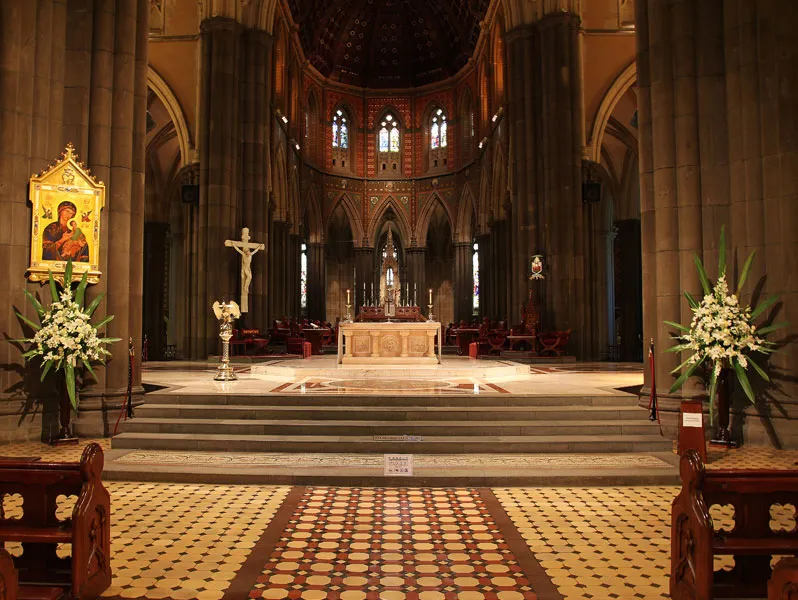
The chief draw card might be the ascending basalt columns, the gleaming mosaics and marble which highlight architect William Wardell’s wonderful design. But for the Catholic community this building holds Archbishop Peter A Comensoli’s chair (Latin: cathedra) on the sanctuary, which represents his prayerful leadership of our sacramental celebrations and pastoral life. Our parishes are connected to, and look towards, the cathedral for spiritual inspiration and connection to the Church of Rome. Our cathedral is dedicated to St Patrick, the pioneering Irish bishop who faithfully and courageously led the Church in Ireland and who initiated many changes to that society.
Our cathedral also enjoys a rare distinction in design. The windows in the nave, unlike the usual stained-glass style, are made of translucent alabaster that gives the body of the building a golden glow. The lay people who pray and celebrate the sacred mysteries at ‘St Pat’s’ are placed in a luminous clearing and bathed in a glorious tint. The dignity of their baptism, friendship with Christ and membership of his body is affirmed in this unique hue. The central spire is no longer the tallest structure in the Melbourne cityscape, nevertheless, for the friends of Christ, everything we celebrate about God’s love for us in the cathedral is meant to be heard throughout our city and state.
Restoration
To celebrate the centenary of its consecration in 1997, the cathedral was closed throughout 1994 to be upgraded. Nothing was added to the main building. Rather, it underwent significant conservation work, with funds contributed by the federal and Victorian governments, corporate and philanthropic donors and the community of Melbourne.
The cathedral’s stained glass windows had buckled and cracked and required a full year to restore to their original state. Teams of stonemasons and stained-glass craftsmen used “lime mortars and materials long-forgotten by the building trade — like medieval times”. The 1992–97 restoration works were undertaken under the guidance of Falkinger Andronas Architects and Heritage Consultants. The works were awarded the Royal Australian Institute of Architects (Victorian Chapter) John George Knight Award for Heritage Architecture 1996. One of the gargoyles restored by the masonry team was modelled on the then-Premier of Victoria, Jeff Kennett.
Cathedral choir
There has been music at St Patrick’s since 1858, but the present cathedral choir was founded in 1939 when the Vienna Mozart Boys Choir found itself stranded in Australia at the outbreak of war. The National Museum of Australia holds a collection of the choir’s memorabilia from this period. St Patrick’s choir has between 50 and 60 members who are all students of St Kevin’s College in Toorak, through a scholarship program from the archdiocese. The choir has made commercial recordings in the past, mainly from the 1950s to 1990s. Selected recording before the 1980s have been deposited with the National Film and Sound Archive (Screensound Australia).
Cathedral singers
Formed in May 1996, the St Patrick’s Cathedral Singers supplement the musical resources of the cathedral. The choir has been directed since 2015 by Mr Christopher Mason. The Singers sing weekly at the Sunday 6:30pm Mass. Entrance is by audition and some scholarships are available to eligible students.
The Bells
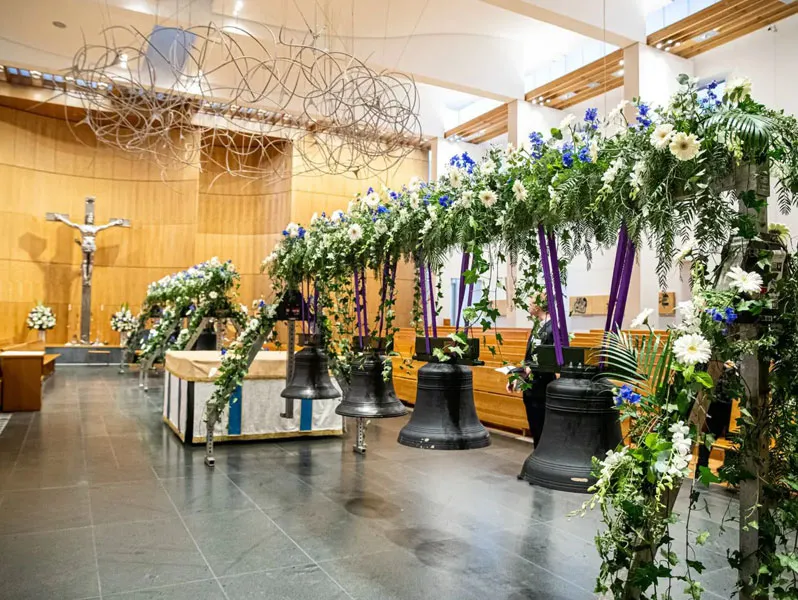
The bells of the cathedral were acquired by Bishop Goold, Melbourne’s Roman Catholic leader at the time, when he visited Europe in 1851–1852. He bought a peal of eight bells for £500 (with some records showing that it cost £700). They arrived in Australia in 1853. The peal of eight bells is in F natural, with the tenor weighing 12 long cwt 1 qr 10 lb (1,382 lb or 627 kg) and the treble 4 long cwt 12 qr 14 lb (798 lb or 362 kg). The peal set weights around 3,556 kilograms (7,840 lb). The bells were all cast by John Murphy of Dublin in 1852.
The bells were hung in a low frame at ground level in the western aisle in 1868. The consecration service was attended by around 5,000 people. The eight bell bears the coat of arms of Bishop Goold. The bells were eventually hung at the south-eastern tower.
The ringers of St Patrick’s began the custom of ringing in the New Year in 1871. And by the 1880s, St Patrick’s Cathedral became the leading tower for Australian change ringing. The bells were rung for the requiem mass of Pope Pius X in 1914. By 1959 the belfry fell into disrepair and the bells became unringable. The bells remained silent until in 1988, when the peal was sent to Eayre and Smith Bell foundry in England as the major Victorian project among Bicententennial bell restorations. Upon their return, a ninth bell, an Angelus bell, was added. An electronic chiming mechanism was also installed at this time for all the bells. The original manual method was retained by the electronic mechanism, in order to replicate how the bells would have sounded if they were rung by hand. The entire eight headstocks had to be replaced just ten years after this installation. The ringers are affiliated with The Australian and New Zealand Association of Bellringers. The bells are unusual in that they were cast untuned, they ring anti-clockwise instead of clockwise, and they are thought to be the only ring of eight bells cast by Murphy which are still in operation today.
Annual Feast Day
Feast day: March 17
Patrick’s Cathedral, Melbourne Feast day March 17
Mass Timing
Monday to Friday: 7am and 1pm
Wednesday: 5:30pm (Latin Mass)
Saturday: 8am and 6pm (Vigil Mass)
Sunday: 8am, 9:30am, 11am and 6:30pm
The 1pm Mass (Monday to Friday) and 8am Mass (Saturday) are livestreamed to the Archdiocesan YouTube Channel. On Sundays, the 11am Mass is livestreamed and televised on Community Channel C31 (Channel 44 on digital television).
Contact Info
St Patrick’s Cathedral,
St Patrick’s Centre,
486 Albert Street,
East Melbourne VIC 3002,
Australia.
Phone No.
Phone:+61 3 9926 5677
Accommdations
Connectivities
Airway
Melbourne Airport (MEL) to St Patrick’s Cathedral Duration 42 min Distance 19 km
Railway
11-Albert St/Gisborne St (East Melbourne) is 70 meters away, 2 min walk. 12-St Vincents Plaza/Victoria Pde (East Melbourne) is 215 meters away, 4 min walk.

